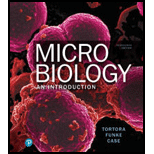
Concept explainers
Introduction:
Salmonella, a genus of gram-negative, rod-shaped, cytochrome oxidase-negative, lactose-negative, non-sporulating bacteria that is the etiological agent of Salmonella gastroenteritis or salmonellosis.
Case summary:
A person (31-year old-male) became feverish 4 days after arriving at a vacation resort in Idaho. During his stay he ate at two restaurants that were not associated with the resort. At the resort he drank soft drinks with ice, used the hot tub, and went fishing. The resort is supplied by a well that was dug 3 years ago. He went to the hospital when he developed vomiting and bloody diarrhea. Gram-negative, lactose-negative bacteria were cultured from the stool sample. The patient recovered after receiving intravenous fluids.
Characters of the case:
- A patient (Male) – 31 years old
- Vomiting and bloody diarrhea
- Gram-negative, lactose-negative bacteria
- Pathogen cultures from stool sample
Want to see the full answer?
Check out a sample textbook solution
Chapter 25 Solutions
Microbiology: An Introduction Plus Mastering Microbiology with Pearson eText -- Access Card Package (13th Edition) (What's New in Microbiology)
- please fill in the empty sports, thank you!arrow_forwardIn one paragraph show how atoms and they're structure are related to the structure of dna and proteins. Talk about what atoms are. what they're made of, why chemical bonding is important to DNA?arrow_forwardWhat are the structure and properties of atoms and chemical bonds (especially how they relate to DNA and proteins).arrow_forward
- The Sentinel Cell: Nature’s Answer to Cancer?arrow_forwardMolecular Biology Question You are working to characterize a novel protein in mice. Analysis shows that high levels of the primary transcript that codes for this protein are found in tissue from the brain, muscle, liver, and pancreas. However, an antibody that recognizes the C-terminal portion of the protein indicates that the protein is present in brain, muscle, and liver, but not in the pancreas. What is the most likely explanation for this result?arrow_forwardMolecular Biology Explain/discuss how “slow stop” and “quick/fast stop” mutants wereused to identify different protein involved in DNA replication in E. coli.arrow_forward
- Molecular Biology Question A gene that codes for a protein was removed from a eukaryotic cell and inserted into a prokaryotic cell. Although the gene was successfully transcribed and translated, it produced a different protein than it produced in the eukaryotic cell. What is the most likely explanation?arrow_forwardMolecular Biology LIST three characteristics of origins of replicationarrow_forwardMolecular Biology Question Please help. Thank you For E coli DNA polymerase III, give the structure and function of the b-clamp sub-complex. Describe how the structure of this sub-complex is important for it’s function.arrow_forward
- Basic Clinical Lab Competencies for Respiratory C...NursingISBN:9781285244662Author:WhitePublisher:Cengage
 Human Heredity: Principles and Issues (MindTap Co...BiologyISBN:9781305251052Author:Michael CummingsPublisher:Cengage Learning
Human Heredity: Principles and Issues (MindTap Co...BiologyISBN:9781305251052Author:Michael CummingsPublisher:Cengage Learning





